 |
The photo shows a trial fit of the new sill, but I'll need to make a few repairs to the rear of the car before the new sill can be attached. The chassis top and bottom sections and the B pillar inner reinforcement all need to be replaced. So much needs to be removed that I'll need to be very careful with the sequence of repairs in this area so I don't lose sill alignment. I've added some extra parts to my chassis jig to be on the safe side. |
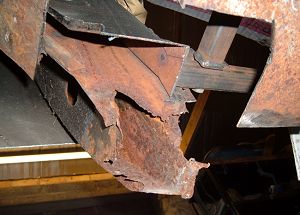 |
The problem repair was the B pillar inner reinforcement due to it's inaccessibility. I chose to approach it from the inside as part of the chassis top had also rusted and needed to be replaced. Also I wanted to leave the outer B-pillar in place to help align the outer sills. The photo is taken from where the chassis would normally be. I've removed the top of the chassis member and part of the rear wheelarch to access the B-pillar inner reinforcement. |
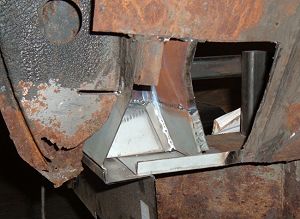 |
I used the other side of the car as a guide to the shape of the B-pillar as the new section pictured to the left of the photograph had almost completely corroded away. The top of the chassis was the next part to be repaired, followed by the inner B-pillar reinforcements. |
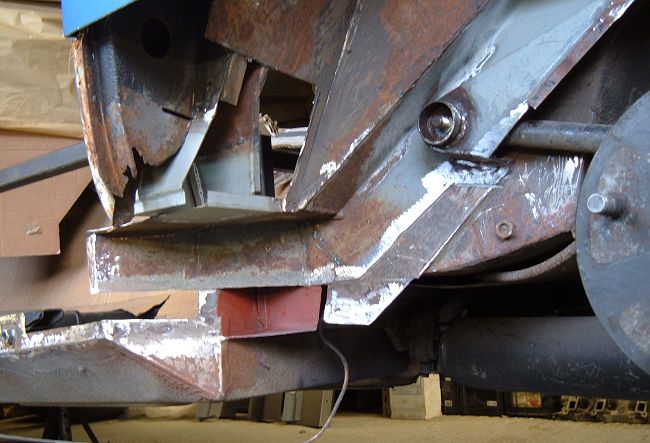 |
The chassis beneath the B-pillar has also rusted. I cut the chassis back to clean metal leaving the inner reinforcements in place. The shiny metal to the right of the red painted part is a second skin which was still in good condition. This will provide reinforcement for the joins in the chassis that will be necessary in this area. |
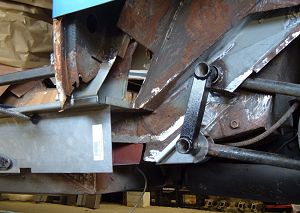 |
The lack of reference points in this area was resolved with a simple suspension jig. The jig holds the new lower radius arm mounting at the correct height and distance outboard, while the radius arm maintains the correct fore-aft position. I checked the rear suspension alignment and it's good. I'm getting ahead of myself, as the only part I needed to align the new chassis section below the B-pillar was the inner sill. |
 |
The new chassis lower section could now be used to align the rear chassis section that supports the radius arm mountings. This new section had already reached the template stage by the time this photograph was taken. I tend to make templates for each new part using thin cardboard. |
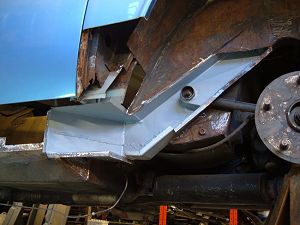 |
With the cardboard replaced by steel I now had a complete rear chassis (less outer sections). The rear chassis still needs an inner reinforcement before the closing panel is added, but I now have enough to attach the inner sill. |
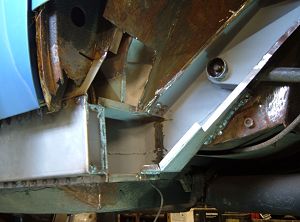 |
Once the new sills had been fitted, work on the rear chassis could continue. |
 |
I've deviated from the original structure by closing the front of the rear chassis with a thicker sheet of metal than was originally fitted. This will add further stiffness to the chassis. The sheet has been extended into the chassis to act as a stiffener (modern practice at an angled joint in the chassis) and will also separate the sills and the rear chassis to reduce the chance of rust spreading from one to the other. |
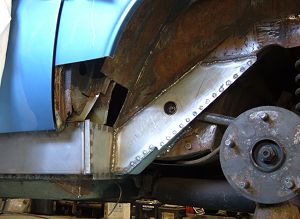 |
The thin wheelarch panel originally extended to the bottom of the rear chassis side member which was then reinforced by a second skin. Double skins are notorious for rotting from the inside out, so I've fitted a single thicker sheet of metal which will be just as strong but much less prone to rust. |
 |
Finally the jig was used to position the rear suspension mounting which was then seam welded in place. With the lower radius arm in place the upper arm could be removed to complete the welding in that area. |
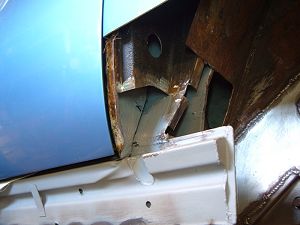 |
With the outer sill in place repairs could commence on the B-pillar outer sections. The photograph shows the rear face of the B-pillar which has been cut away.
|
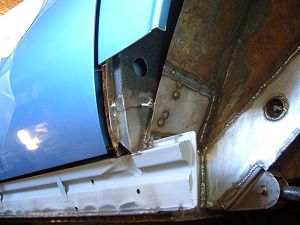 |
The rear face of the B-pillar turned out to be quite tricky to make. Despite it's small size the repair panel had five folds, two of which were curved. With the B-pillar rear repair in place the front of the wheelarch was closed. |
 |
The repair to the front of the B-pillar was much more simple as the panel had only rusted on it's inner flange. A further repair section was fitted to the door seal flange to replace the section that had been cut away to access the rusty parts. |
| Next: A-Pillar welding and the new sills. Or back to: Aston Martin Restoration |
|